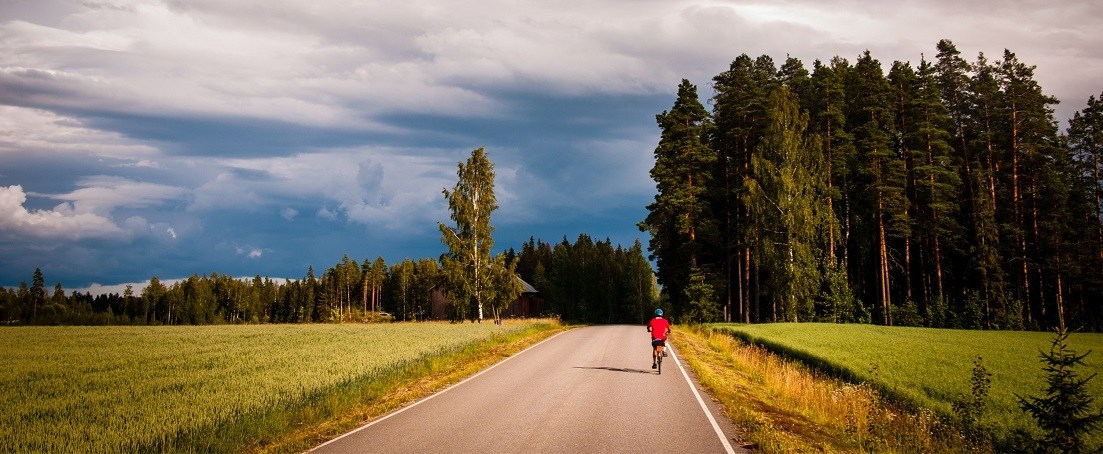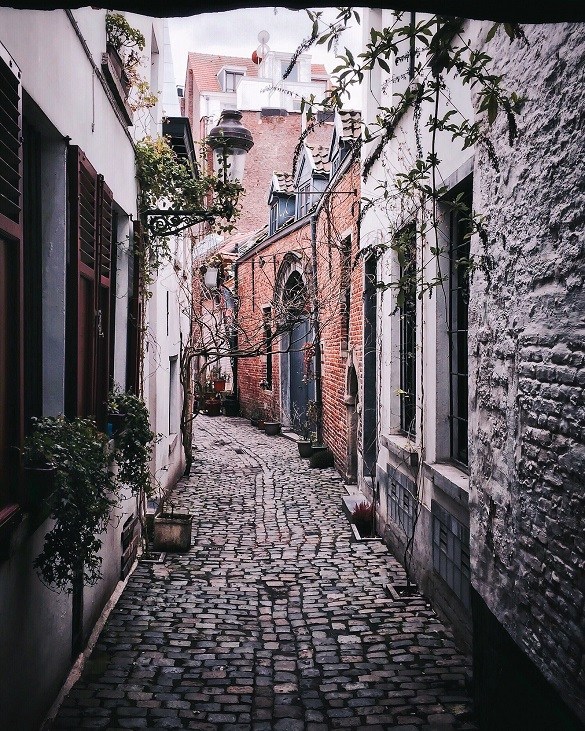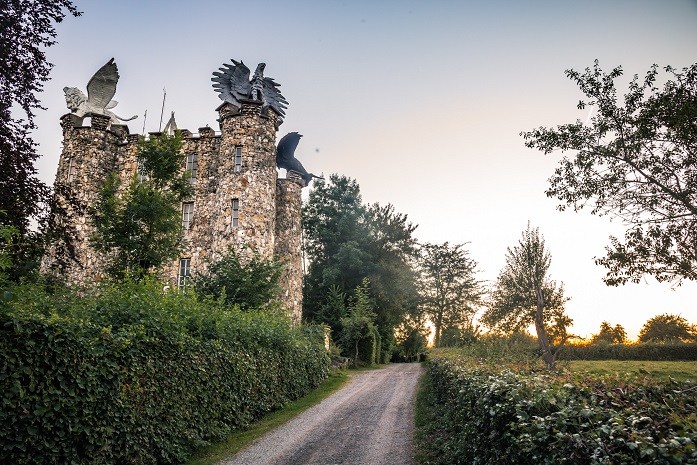It might get overcrowded this summer in many parts of Belgium, but Derek Blyth, author of Hidden Belgium, knows a few places that are off the beaten track. Here are his tips for a quiet trip during the coronavirus summer.
Wild bike rides in Limburg
When the coal mines closed in the 1990s, Limburg reinvented itself as a tourist destination. Several abandoned mines were turned into cultural centres and the scarred landscape was allowed to return to the wild.
Then the region hit on a plan to become a “cycling paradise.” Limburg has a lot of advantages over other regions – the landscape is flat, distances are short and the cycle network is dense.
The plan really took off after Hugo Bollen came up with a brilliant idea. A former mining engineer, he developed a cycling network based on numbered signs known as knooppunten. Instead of relying on road signs to navigate, Bollen’s network allows you to create a route based on numbers. So you just need to note down a string of numbers like 4, 12, 99, 98. And off you go.
People were sceptical when Bollen launched the plan in 1995. But there are now 12,000 kilometres of knooppunten routes across the country, along with similar networks in the Netherlands, Germany and as far off as Croatia.
Limburg province has gone on to create a series of unique cycling experiences to persuade people to hop on their bikes. The first was a short route near Bokrijk open-air museum called fietsen door het water (cycle through water). This takes you on a metal bridge sunk below a pond so you are literally under the water.
Next in line was fietsen door de bomen (cycle in the trees) in Hechtel-Eksel. This feature aims to draw cyclists to the wild forested landscape of the Bosland nature reserve. Designed in 2019, by architects De Gregorio & Partners, it involves a stunning structure supported on rugged rust-red steel stilts that merge seamlessly with the lofty pine trunks. Cyclists ride up a gently sloping 700-metre-long circular ramp to reach the tree tops, ten metres above the ground. Once you are back at ground level, you can set off through the Bosland woods on a series of numbered routes, and end up in the bike-friendly café De Lage Kempen.
The latest adventure to attract cyclists is called fietsen door de heide (cycle through the moors). Opened a few months ago, a 300-metre wooden cycle bridge links two areas of the Hoge Kempen nature park that are separated by a main road. The region is now working on a fourth attraction called fietsen onder de grond (cycle under the ground), which will take you through a series of dark caves.
Hautes Fagnes
Anyone who says Belgium is overcrowded and flat has never been to the Hautes Fagnes. This is one of the wildest upland regions in northern Europe, marked by misty hills, dark forests and soggy marshes. “Snow half the year, bad weather the other half,” observed a professor from Brussels who decided to renovate the ruined Reinhardstein castle on the edge of the moors.
He wasn’t wrong. The rainfall here is twice the national average. Even in summer, the mist can come down suddenly, wrapping everything in a sinister silence.
Reinhardstein had been a desolate ruin for 150 years when Brussels historian Jean Overloop stumbled upon it in 1969. Working with local craftsmen, he carefully restored the grim stone fortress and furnished the interior in atmospheric mediaeval style with tapestries, oak chests and armour.
Perched high on a rocky outcrop above a misty valley, its foundations date back to 1354. Owned for three centuries by the Metternich family, it was finally abandoned in the early 19th century. Now restored to its old state, it is reached from Robertville reservoir along a dark forest trail. You can visit the interior on a one-hour guided tour and then drink a local Reinhardstein beer in a rustic wooden chalet.
The long-distance hiking trail GR 573 crosses this bleak upland region where nothing much can survive apart from tough heather and isolated pine trees. The trail passes the Signal de Botrange, which is the highest spot in Belgium, 648 metres above sea level. A stone staircase built here in 1923 leads nowhere, but adds a further six metres of height to reach the round figure of 700 metres. Eleven years later, a stone observation tower was built 18 metres above ground level, so the little stone staircase has no purpose any more.
This is a culturally confusing region with a mix of Belgian and German influences. It used to be Prussian up until the end of the First World War. Then it became Belgian. Everyone got a new passport, but they kept German as their first language. It’s hardly surprising it feels such strange, lost place.
No one lives in this cold, marshy region of Europe. There is not a single house to be seen. You sometimes have to walk along raised wooden walkways to avoid the waterlogged marshes, and at one point pass a cross where two lovers died in a storm. As you tramp across the moorland, you can observe a rich variety of rare species growing in the soggy ground. You might also, if you are lucky, spot deer, a fox or maybe even a family of wild boar.
One of the few buildings in this desolate region is the ancient inn called Baraque Michel where travellers have been sheltering from the wind and rain for centuries. It’s a rustic German-style place with heavy wood tables, an old stove and baskets filled with logs. The perfect spot for some Ardennes home cooking and a glass of the house beer.
Reinhardstein Castle, Chemin du Cheneux 50, Ovifat
+32 (0)80 44 68 68, reinhardstein.net
Euro bike trails
Most travels options are difficult this summer. You can’t easily fly, take a train or drive across Europe. But cycling is one way to travel that hasn’t been hit by coronavirus regulations. So why not think about a slow bike tour across Belgium, crossing into Germany, France or the Netherlands (if the borders are open).
It used to a scary idea. It was impossible to know if the route you planned was possible on a bicycle. But the Brussels-based European Cyclists’ Federation (ECF) has mapped out a series of 16 long-distance routes across the entire European continent. The routes follow approved cycle paths, canal routes and river trails, making it possible (in theory at least) to cycle all the way from Brussels to Athens.
But if that seems a bit of a challenge, you can start off this summer by following one of the three routes that runs across Belgium, such as the Belgian stretch of the 5,300 km Pilgrims’ Route. Entering the country near Aachen, the trail runs through southern Belgium along the Meuse river valley, then passes through the surprisingly rural landscape around Charleroi.
The 3,200 km Via Romea also crosses through Belgium on the long haul from Calais to Rome. Starting in Brussels, you might decide to follow the route east through the gentle landscape of Hainaut province to reach Lille. Or you could head off in the opposite direction to reach the Ardennes and eventually Luxembourg.
The ECF is currently campaigning to persuade train operators to allow a fixed number of bikes on trains. Otherwise, you might find yourself 3,000 km from home with no easy way to get back.
Get lost in a forgotten neighbourhood
What everyone is looking for this summer is a quiet spot in Belgium, far from anyone else, where you can sit with a book, and a coffee, and just relax. Well, it’s not going to be easy, unless you are lucky enough to have a private garden. Most Belgians will be staying at home this summer, everyone looking for the same thing.
Here is what I think. You can forget about the Belgian beach because it is going to be crowded and stressful. And you can also drop any plans to visit popular destinations like Bruges, Durbuy or Antwerp Zoo. This is a summer for doing some creative thinking about travel.
My suggestion is to spend some time strolling through quiet Belgian neighbourhoods. The traffic has dropped to a level not seen in 50 years, so you have a unique opportunity to explore places that are normally noisy and polluted. By the summer of 2021, the traffic might be back. Grab this moment while it lasts.
You might be surprised at what you discover. This small country is packed with interesting town houses, squares, railway viaducts, museums and parks. Every neighbourhood has a different atmosphere, a special charm. You don’t need to plan a route, just wander along quiet streets to see what you find. No phone. No Google. Pick up a takeaway coffee along the way. Post a photo on social media if you see something interesting. And head home when you are done.
You might begin with an aimless walk in Brussels to see where it takes you. The city has many unique and authentic neighbourhoods, like Saint Gilles commune, where the streets are dotted with beautiful Art Nouveau buildings. For a more rural atmosphere, wander through the neighbourhood around Ixelles Museum where local residents have filled narrow streets like Rue Van Aa with climbing plants.
You can get lost in other cities too. Antwerp has neighbourhoods that are never too crowded, like the streets around Berchem Station where wealthy owners built fabulous town houses at the end of the 19th century. You find examples of every architectural style imaginable along the tree-lined Cogels-Osylei avenue, from a Venetian palazzo to a Gothic castle.
Ghent also has some fascinating neighbourhoods including a docklands area which almost no one knows about. Located to the east of the old town, this forgotten quarter has impressive waterfront quays, restored warehouses and industrial ruins. The street artist Roa used to wander around here decorating abandoned walls with his meticulous animal paintings. You might still come across an early Roa, like a faded bird, or a pile of sleeping rabbits.
Kanne
The Flemish village of Kanne, near Maastricht, stands next to the River Jeker in a surreal landscape of limestone hills. With a population of 1,200, the “white village on the Jeker” has a remarkable 464 protected buildings, including houses built with the mellow local stone, and a 1647 church modelled on the Church of the Holy Sepulchre in Jerusalem. A plaque on the wall of the Hotel Huize Poswick recalls a mysterious incident on 18 August 1914 when German soldiers shot the mayor’s wife and a local lawyer. No one knows why.
The strange limestone hills around the village have been quarried for building material since the middle ages. The local Limburg mergel has been used to build farms, houses and churches all along the Meuse valley. But the last quarry closed in 2018, leaving behind a network of underground caves used for mushroom cultivation, candlelit wedding receptions and adventurous cycle trails.
This upland border region could be the perfect area to escape the summer crowds. You can follow several marked trails through the unique limestone landscape starting in the village of Kanne. One route, marked with orange crosses, leads you past a Dutch vineyard, an abandoned Cold War bunker and a huge lock complex.
The border between the Netherlands and Belgium is marked out here by iron posts dating from 1843. But there is a second invisible border separating French-speaking Belgium from Dutch-speaking Belgium. Back in Kanne, you should have no trouble finding a café or ice cream salon. Not too crowded, let’s hope.
Kanne, Limburg province
By Derek Blyth





